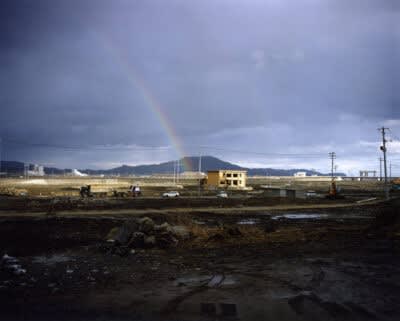
Last Monday night I attended a lecture by Naoya Hatakeyama that impacted my thoughts on viewing a photograph.
This lecture is on a new body of work on the aftermath of the tsunami that destroyed his home town, Rikuzentakata, Iwate Prefecture, Japan. I was previously familiar with Hatakeyama’s “Blast” series, which I like very much. What intrigued me most were his comments on a photographer’s relationship to their work, and the interaction of a viewer with a photographer’s work.
An element in Hatakeyama’s talk was the expression of how a photographer relates to their work, especially when the event is personal to you. There is a connection to the creation and examination of those images that is different from a photographer who does not have a personal connection to the place. For Hatakeyama the relationship crosses time in that he presented images from before the tsunami disaster, images of the destruction caused by the 9.0 magnitude earthquake on March 11, 2011, and images of reconstruction that is occurring now in the aftermath and clean-up.
In the years prior to this event, Hatakeyama had taken “snapshots” of the area, friends and families that he said he never intended to exhibit. These were personal. These images are done without concern for one’s artistic styles and whether a “personal” photo is consistent with other bodies of work done as a artist or professional photographer. As a result of the event, these images became a testament to what existed in Rikuzentakata before. These casual personal images took on a new importance. This has permanently changed my view of “snapshots”, and that those casual images one takes can become tremendously important as a result of events beyond our control.
Hatakeyama, I believe, said that these images are his observations of the event, and are not meant to be documentary. The images are his way of expressing his feelings about what happened. Sharing these images is his way of dealing with the crisis and to be “responsive”. As he seemed to say, it was his way of allowing life to go on. I have also struggled with making a distinction between “documentary” photography and photography that is recording an observation of an event that is not making a political , economic or social commentary. For me, he achieved that distinction. As a viewer, I felt that I could sense something of the change that happened in that area of Japan, but also felt the difference between the photographer who has a personal connection to the place and event, and one who is an outside viewer to the event. That it was an observation for one, and documentation for the other.
He also commented that the size in which an image is presented should be a conscious decision that impacts the viewer’s relationship to the photograph. The photographs shown took us through three periods of time: an ordered life prior to the earthquake, the chaos of the event and tsunami, and the reconstructive period afterwards of rebuilding and recreating order in the damaged region for people’s lives and the physical infrastructure of the area. Hatakeyama expressed that the images are in smaller sized prints to create an “intimacy” for the viewer rather than the very large prints one normally encounters in an installation. He seemed to express that the smaller size instills in a viewer more of a “respect” for the crisis than what otherwise might be felt looking at images of a disaster.
What I took away from Hatakeyama’s lecture transcended the events of March 11, 2011. He created for me a different place from which I will view a photographer’s reaction to a crisis in which they have a personal connection. I will engage with documentary photographs taken by an “outsider” to an event differently now than if I know the photographer has a personal connection to a place.

